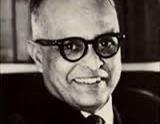In a way, the marvelous 1958 comic novel The Guide, by R. K. Narayan, is an undidactic illustration of the maxim of La Rochefoucauld, ” Fortune and caprice govern the world.”
Narayan (1906-2001) is perhaps the most famous Indian author of fiction writing in English. His style is wonderfully limpid. He wrote novels and short stories of contemporary India (particularly about his fictional South Indian Tamil-speaking town of Malgudi) and retold Indian legends, including the two grand epics The Ramayana and The Mahabharata.
The Guide follows Raju, the only child of a small shopkeeper who becomes fairly well-to-do when a railroad station is built near his shop. Raju runs the business after his father dies. Eventually, he becomes a well-known tourist guide, spurred on by his natural extroversion and his desire to supplement his income.
Raju does not have much real interest in the places to which he takes his customers , and he even makes up dates of sites depending upon his mood. In other words, he is something of a poseur. Yet he becomes quite successful, if only because of his being near the train station.
He meets a married couple and becomes their tour guide, and this eventually leads him to become a different sort of guide. The husband is a wealthy man with a scholarly interest in archaeology and wishes to see some cave paintings. His wife, Rosie, comes from a line of temple dancers. According to the novel, such dancers are looked down upon, and so her mother sent her off to college, where she earned degrees in economics. But Rosie has a love for classical Indian dance, and a talent for it as well.
Raju becomes infatuated with her and, in his efforts to seduce her, Raju arranges for her to take up dance. She becomes a phenomenal success, with Raju as her manager. Thus Raju plays a role in a revival of interest in Indian classical dance. In a way, he becomes a sort of guide to dance for the Indian populace, though he has little interest in or knowledge of it.
Without intending it, Raju eventually winds up taken to be a holy man, a yogi, by villagers near his home town of Malgudi. Once again, the poseur succeeds, in a way, as a guide. Raju thinks, “The essence of sainthood seemed to lie in one’s ability to utter mystifying statements.”
Near the end of Raju’s playing of this final role as spiritual guide, Narayan writes, “For the first time in his life he was making an earnest effort,… learning the thrill of full application, outside money and love,… doing a thing in which he was not personally interested.”
However, the ending of the tale is ambiguous. Raju has certainly achieved a measure of self-awareness, but has he really achieved any deep and lasting moral elevation? Narayan leaves it up to the reader to decide.
Told in both first person (Raju) and third person, The Guide a is a tale suffused with irony. The irony is amusing, rather than bitter, so this is a comedy rather than a satire. It is a comedy of caprice, and also (call it fortune if you wish) of how human actions can have unforeseen effects because of our connections to one another.


